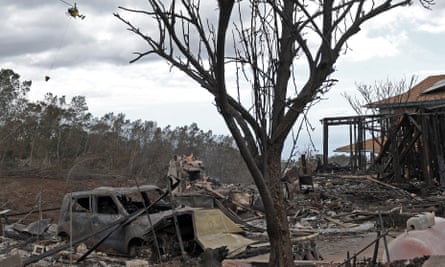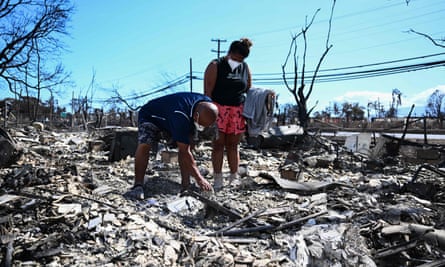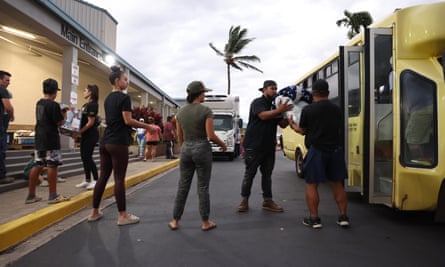Hawaii Fires: Fresh Blaze Prompts Renewed Evacuations as Maui Death Toll Rises
ENVIRONMENT, 14 Aug 2023
The Observer/Guardian - TRANSCEND Media Service
At least 80 people killed in deadliest disaster in the state’s history, as questions asked about the local warning system.
12 Aug 2023 – The death toll from the Maui wildfires in Hawaii has risen to 80 as search teams comb through the smouldering ruins of Lahaina and a new fire triggered the evacuation of another community on Friday night.
The Maui police department said the new fire was burning in Kaanapali in West Maui, to the north-east of the area that burned earlier this week.
No details of the evacuation were immediately provided in the police post on social media. But officials have since said that the blaze was 100% contained, and no further evacuations would be necessary, according to a report by the local news station KHON.
The new fire and rising death toll came as Hawaiian officials sought to determine how the initial inferno spread so rapidly through the historic town of Lahaina with little warning.
Some residents ran into the sea to evade the flames, or hopped into their cars just in time. Others did not make it. As survivors and first responders returned to the wreckage this weekend, they saw an eerie traffic jam of charred cars. Buildings were hollowed into blackened husks, and even boats at harbor were scorched.
Officials have confirmed that Hawaii’s emergency management records showed no indication that public warning sirens were triggered, despite what the state describes as the largest integrated outdoor all-hazard public safety warning system in the world.
The office of Hawaii’s attorney general, Anne Lopez, would conduct a comprehensive review of decision-making and standing policies leading up to, during and after the wildfires, she said.
“My department is committed to understanding the decisions that were made before and during the wildfires and to sharing with the public the results of this review,” Lopez said. “As we continue to support all aspects of the ongoing relief effort, now is the time to begin this process of understanding.”
READ MORE: Devastating Hawaii fires made ‘much more dangerous’ by climate change
The fires became the deadliest natural disaster in the state’s history, surpassing that of a tsunami that killed 61 people on the Big Island of Hawaii in 1960, a year after Hawaii joined the US.
Thousands have been displaced, and officials across the islands are coordinating efforts to shelter survivors. Honolulu suspended its restrictions on short term rentals to accommodate Maui wildfire survivors, and the city’s mayor encouraged property managers to provide free or discounted accommodations to the displaced.
Officials have warned that search teams with cadaver dogs could still find more dead from the fire that torched more than 2,000 structures and left thousands homeless, likely requiring many years and billions of dollars to rebuild.

“Nobody has entered any of these structures that have burned down and that’s where we unfortunately anticipate that the death toll will rise significantly,” US senator Brian Schatz of Hawaii told MSNBC on Friday.
He later told CNN that Lahaina resembled a bombed-out war zone where the heat had melted engine blocks.
In areas surrounding the fires zones, officials have also warned that the fires could have compromised water systems with carcinogenic benzene, advising residents to drink bottled water.
The Lahaina fire that spread from the brush to town was still burning but 85% contained, Maui county said in a statement. Two other wildfires on the island were 80% and 50% contained.
Three days after the disaster, it remained unclear whether some residents had received any warning before the fire engulfed their homes.
The island has emergency sirens intended to warn of natural disasters and other threats, but they did not appear to have sounded during the fire.
“I authorised a comprehensive review this morning to make sure that we know exactly what happened and when,” Hawaii’s governor, Josh Green, told CNN, referring to the warning sirens.

Officials have not offered a detailed picture of precisely what notifications were sent out, and whether they were delivered via text message, email or phone calls.
Green described multiple, simultaneous challenges, with telecommunications down and firefighters concentrating on other major wildfires when the greatest threat to Lahaina arose.
He added: “We will do all that we can to find out how to protect our people more going forward.”
Maui County fire chief, Bradford Ventura, said the fire’s speed made it “nearly impossible” for frontline responders to communicate with the emergency management officials who would typically provide real-time evacuation orders.
“They were basically self-evacuating with fairly little notice,” he told a Thursday press conference, referring to residents of the neighbourhood where the fire initially struck.
Richard Bissen, the mayor of Maui county, told NBC’s Today show on Friday that he did not know whether sirens went off but said the fire moved extraordinarily quickly.
“I think this was an impossible situation,” he said.
The disaster began unfolding just after midnight on Tuesday when a brush fire was reported in the town of Kula, roughly 35 miles (56km) from Lahaina. About five hours later that morning, power was knocked out in Lahaina, according to residents.
In updates posted on Facebook that morning, Maui county said the Kula fire had consumed hundreds of acres of pastureland, but that a small three-acre (1.2-hectare) brush fire that cropped up in Lahaina had been contained.
By that afternoon, however, the situation had turned more dire. About 3.30pm, according to the county’s updates, the Lahaina fire suddenly flared up. Some residents began evacuating while people, including hotel guests, on the town’s west side were instructed to shelter in place.
In the ensuing hours, the county posted a series of evacuation orders on Facebook as the fire spread through the town.

Some witnesses said they had little advance notice, describing their terror when the blaze consumed Lahaina in what seemed a matter of minutes.
The Lahaina evacuation was complicated by its coastal location next to hills, meaning there were only two ways out, at best, said Andrew Rumbach, a specialist in climate and communities at the Urban Institute in Washington.
“This is the nightmare scenario,” said Rumbach, a former urban planning professor at the University of Hawaii. “A fast-moving fire in a densely populated place with difficult communications, and not a lot of good options in terms of evacuations.”
County officials began allowing Lahaina residents back to their homes on Friday, even though much of Maui’s western side remained without power and water. But the long traffic jam on the Kuihelani Highway crawled to a halt after an accident killed a pedestrian and led officials to close the highway in both directions.
Police barricaded central Lahaina as health officials warned the burnt areas were highly toxic and that inhaling dust and airborne particles was hazardous.
“Hotspots still exist and wearing a mask and gloves is advised,” Maui county said in a statement.
______________________________________________
Reuters and Associated Press contributed to this report.
Go to Original – theguardian.com
Tags: Climate Change, Environment, Forest fires, Global warming, Hawaii, Lahaina, Maui, Wild fires
DISCLAIMER: The statements, views and opinions expressed in pieces republished here are solely those of the authors and do not necessarily represent those of TMS. In accordance with title 17 U.S.C. section 107, this material is distributed without profit to those who have expressed a prior interest in receiving the included information for research and educational purposes. TMS has no affiliation whatsoever with the originator of this article nor is TMS endorsed or sponsored by the originator. “GO TO ORIGINAL” links are provided as a convenience to our readers and allow for verification of authenticity. However, as originating pages are often updated by their originating host sites, the versions posted may not match the versions our readers view when clicking the “GO TO ORIGINAL” links. This site contains copyrighted material the use of which has not always been specifically authorized by the copyright owner. We are making such material available in our efforts to advance understanding of environmental, political, human rights, economic, democracy, scientific, and social justice issues, etc. We believe this constitutes a ‘fair use’ of any such copyrighted material as provided for in section 107 of the US Copyright Law. In accordance with Title 17 U.S.C. Section 107, the material on this site is distributed without profit to those who have expressed a prior interest in receiving the included information for research and educational purposes. For more information go to: http://www.law.cornell.edu/uscode/17/107.shtml. If you wish to use copyrighted material from this site for purposes of your own that go beyond ‘fair use’, you must obtain permission from the copyright owner.